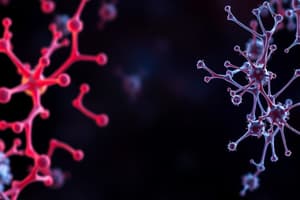Podcast
Questions and Answers
Which characteristic is primarily associated with the innate immune system?
Which characteristic is primarily associated with the innate immune system?
- Production of memory cells
- Delayed response to infection
- Rapid defense mechanism (correct)
- Specificity for particular antigens
How do commensal microbes contribute to the innate immune system's defense against pathogens?
How do commensal microbes contribute to the innate immune system's defense against pathogens?
- By enhancing the inflammatory response to accelerate pathogen clearance.
- By directly attacking pathogenic bacteria through phagocytosis.
- By producing antibodies that neutralize pathogenic toxins.
- By competing with pathogens and inhibiting their growth. (correct)
Which of the following is an example of a chemical barrier involved in innate immunity?
Which of the following is an example of a chemical barrier involved in innate immunity?
- Cilia lining the respiratory epithelium
- The epidermal layer of the skin
- Lysozyme found in tears (correct)
- Mucus secreted by the respiratory tract
What role do B-lymphocytes play in adaptive immunity?
What role do B-lymphocytes play in adaptive immunity?
Which of the following is a key feature that differentiates adaptive immunity from innate immunity?
Which of the following is a key feature that differentiates adaptive immunity from innate immunity?
Cytokines such as TNF, IL-1, and IL-12 play a critical role in immune responses. What is their primary function?
Cytokines such as TNF, IL-1, and IL-12 play a critical role in immune responses. What is their primary function?
The alternative pathway is a component of the complement system within innate immunity. What is its main role in defense?
The alternative pathway is a component of the complement system within innate immunity. What is its main role in defense?
Longitudinal flow of air and fluid is considered what type of barrier?
Longitudinal flow of air and fluid is considered what type of barrier?
A patient is bitten by a snake and requires immediate treatment. Which type of immunization would be most appropriate?
A patient is bitten by a snake and requires immediate treatment. Which type of immunization would be most appropriate?
Several weeks after receiving a dose of anti-rabies serum following potential exposure to the rabies virus, a patient expresses concern about their long-term immunity. How would you explain the nature of protection provided by the serum?
Several weeks after receiving a dose of anti-rabies serum following potential exposure to the rabies virus, a patient expresses concern about their long-term immunity. How would you explain the nature of protection provided by the serum?
In a population with low vaccination rates, an outbreak of measles occurs. Which of the following outcomes is LEAST likely to be associated with achieving herd immunity through vaccination?
In a population with low vaccination rates, an outbreak of measles occurs. Which of the following outcomes is LEAST likely to be associated with achieving herd immunity through vaccination?
A community experiences a widespread outbreak of tetanus due to a lack of proper wound care and low vaccination rates. Public health officials initiate a mass vaccination campaign. Which of the following interventions would provide the MOST immediate protection to individuals at high risk of contracting tetanus from contaminated wounds?
A community experiences a widespread outbreak of tetanus due to a lack of proper wound care and low vaccination rates. Public health officials initiate a mass vaccination campaign. Which of the following interventions would provide the MOST immediate protection to individuals at high risk of contracting tetanus from contaminated wounds?
Which of the following is a key characteristic that differentiates active and passive immunization?
Which of the following is a key characteristic that differentiates active and passive immunization?
Which of the following characteristics distinguishes T-lymphocytes from B-lymphocytes?
Which of the following characteristics distinguishes T-lymphocytes from B-lymphocytes?
Macrophages and neutrophils are both phagocytes, but they differ in their roles and characteristics. Which statement accurately compares these two cell types?
Macrophages and neutrophils are both phagocytes, but they differ in their roles and characteristics. Which statement accurately compares these two cell types?
A bacterium has evolved a mechanism to interfere with phagocytosis. If this bacterium produces a thick capsule, how does this adaptation promote its survival?
A bacterium has evolved a mechanism to interfere with phagocytosis. If this bacterium produces a thick capsule, how does this adaptation promote its survival?
An individual receives a dose of pre-formed antibodies to protect against a snake venom after being bitten. What type of immunization is this, and what is a key characteristic of this approach?
An individual receives a dose of pre-formed antibodies to protect against a snake venom after being bitten. What type of immunization is this, and what is a key characteristic of this approach?
Which of the following is the most accurate description of how antibodies function within the immune system?
Which of the following is the most accurate description of how antibodies function within the immune system?
An antigen is introduced into a patient. Which of the following statements accurately defines an antigen's key characteristic?
An antigen is introduced into a patient. Which of the following statements accurately defines an antigen's key characteristic?
Which of the following is an example of an immune organ that is part of the immune system?
Which of the following is an example of an immune organ that is part of the immune system?
A researcher is studying the different types of antibodies (immunoglobulins). Which characteristic is NOT shared by all five classes (IgM, IgA, IgG, IgE, IgD) of antibodies?
A researcher is studying the different types of antibodies (immunoglobulins). Which characteristic is NOT shared by all five classes (IgM, IgA, IgG, IgE, IgD) of antibodies?
Flashcards
Immunology
Immunology
The study of how the body defends itself against infectious agents and foreign substances.
Immune System
Immune System
The body's defense against pathogens involving both innate and adaptive responses.
Innate Immunity
Innate Immunity
Non-specific immunity; the body's first line of defense characterized by rapid response and no memory cells.
Adaptive Immunity
Adaptive Immunity
Signup and view all the flashcards
Innate Immunity Barriers
Innate Immunity Barriers
Signup and view all the flashcards
Phagocytes
Phagocytes
Signup and view all the flashcards
Cytokines
Cytokines
Signup and view all the flashcards
Complement
Complement
Signup and view all the flashcards
Neutrophils
Neutrophils
Signup and view all the flashcards
Macrophages
Macrophages
Signup and view all the flashcards
T-Lymphocyte
T-Lymphocyte
Signup and view all the flashcards
Antigen (Ag)
Antigen (Ag)
Signup and view all the flashcards
Antibodies (Immunoglobulin)
Antibodies (Immunoglobulin)
Signup and view all the flashcards
Immunization
Immunization
Signup and view all the flashcards
Passive Immunization
Passive Immunization
Signup and view all the flashcards
Active Immunization
Active Immunization
Signup and view all the flashcards
Antitoxin
Antitoxin
Signup and view all the flashcards
Herd Immunity
Herd Immunity
Signup and view all the flashcards
Active Immunization
Active Immunization
Signup and view all the flashcards
Study Notes
Immunology
- Immunology studies how the body defends itself from infectious agents and foreign substances.
- The immune system protects against pathogens, distinguishing host cells from harmful invaders.
Lines of Defense
- The immune system has two lines of defense: innate and adaptive immunity.
Innate Immunity Specifics
- This is the first line of defense, offering a rapid, non-specific response.
- Innate immunity does not involve memory cells.
- Recognizes and reacts against microbes.
- Prevents microbe entry or eliminates those that enter.
Components of Innate Immunity
- Barriers, including physical (epidermis, mucus membrane, cilia), mechanical (flow of air/fluid, mucus movement by cilia), and biological (commensal microbes inhibiting pathogenic bacteria).
- Chemical barriers like pepsin in the GIT, stomach HCL to kill ingested microbes, and lysozyme in tears.
- Innate immune cells which are phagocytes (macrophages and neutrophils) and NK cells.
- Key cytokines such as TNF, IL-1, IL-12, IFNy, and chemokines.
- Complement alternative pathway.
Adaptive Immunity Specifics
- This is the second line of defense, a delayed but specific response to infection.
- It targets microbes and antigens, differentiating between antigens.
- Consists of memory cells, providing a strong immune response upon re-exposure.
Components of Adaptive Immunity
- B-lymphocytes produce neutralizing antibodies to eliminate extracellular microbes and toxins (humoral immunity).
- T-lymphocytes eradicate intracellular microbes (cell-mediated immunity).
Immune System Cells
- T-lymphocytes and B-lymphocytes.
- Natural killer cells (NK cells).
- Leukocytes, including neutrophils, eosinophils, basophils, mast cells, and monocytes.
- Erythrocytes and platelets.
Phagocytes
- These are cells that recognize, ingest, and kill microbes and foreign bodies.
- Neutrophils are the most numerous WBCs, increasing in acute infections; they are small and live for a few hours.
- Macrophages are fewer in number, large and mononuclear, and live for days.
Stages of Phagocytosis
- Chemotaxis and adherence of microbe to phagocyte.
- Ingestion of microbe by phagocyte.
- Formation of a phagosome.
- Fusion of the phagosome with a lysosome to form a phagolysosome.
- Digestion of the ingested microbe by enzymes.
- Formation of residual body containing indigestible material.
- Discharge of waste materials.
Resistance Against Phagocytosis
- Microbes grow in sites inaccessible to phagocytes.
- Capsules prevent phagocytosis.
- Microbes may kill phagocytes either before or after phagocytosis.
- Survival is possible inside macrophages as intra-cytoplasmic pathogens.
Organs of The Immune System
- Tonsils and adenoids
- Thymus and lymph nodes
- Spleen and Peyer's patches
- Appendix
- Lymphatic vessels
- Bone marrow
Antigens
- Antigens are substances recognized by the immune system, which may be simple or complex.
- The substance can be carbohydrate, lipid, protein, nucleic acid, or phospholipids.
- B cells recognize any biological antigen.
- T cells recognize peptide antigens presented on MHC.
Antibodies
- Antibodies, or Immunoglobulin are Glycoproteins produced in response to antigens.
- Abs belong to the gamma-globulin part of serum proteins.
- Possess Y-shaped or T-shaped polypeptides composed of 2 identical heavy chains and 2 identical light chains.
- NOT all immunoglobulins are antibodies.
- The five kinds of antibodies are IgM, IgA, IgG, IgE, and IgD
Immunization
- Immunizations prepare the immune system to fight infections/diseases by stimulating the immune system.
- A healthy immune system recognizes invading bacteria/viruses and produces antibodies to destroy or disable them.
Passive Immunization
- Involves administering antibodies (Igs) from actively immune humans or animals (serum or antiserum).
- Gives immediate protection to individuals exposed to an infectious organism, and lack active immunity.
- Does not generate a memory response.
- Igs are cleared from the recipient's serum within weeks to months.
- Examples of anti-sera and immune globulins include tetanus antitoxin, gas gangrene antitoxin and anti-rabies serum, anti-snake and anti-scorpion venom polyvalent, normal human gamma globulin human tetanus immunoglobulin, Human Rabies immunoglobulin, Human Hepatitis B immunoglobulin
Active Immunization
- Achieved through natural infection.
- Can also occurs artifically through vaccines.
- Requires several days to months to become effective.
- Leads to prolonged Immunity.
Herd Immunity
- A form of indirect protection from infectious diseases that occurs when a large percentage of a population has become immune to an infection, thereby providing a measure of protection for individuals who are not immune.
- Immunized individuals act a barrier in the spread of the infection and protection of non-immunized individuals.
- Disadvantages can include raising the average age of infection among infected individuals and might result in some mortality rate.
Studying That Suits You
Use AI to generate personalized quizzes and flashcards to suit your learning preferences.




